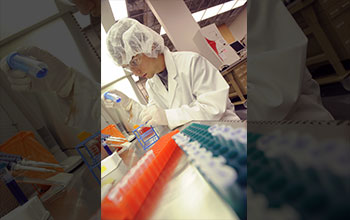Multimedia Gallery
Using nano-link modules to apply nanoscience tools in industry settings
Students use nano-link modules to apply nanoscience tools in an array of industry settings at the Midwest Regional Center for Nanotechnology Education, or Nano-Link, a U.S. National Science Foundation Advanced Technological Education center.
More about this image
Located at Dakota County Technical College in Rosemount, Minnesota, Nano-Link is a collaboration involving six colleges across the upper Midwest. Through its modular packaging of nanotechnology content, Nano-Link enables community colleges and high schools to infuse nanotechnology into curricula in easy stages; creates self-contained, complete and technically sound topical and contextual modules; and coordinates career path options with student abilities, industry needs and university programs.
To learn more about Nano-Link, visit the center's website Here.
About NSF's ATE Program
With an emphasis on two-year colleges, NSF's ATE program focuses on the education of technicians for the high-tech fields that drive our nation's economy. ATE involves partnerships between academic institutions and employers to promote improvement in the education of science and engineering technicians at the undergraduate and secondary school levels. ATE supports curriculum development; professional development of college faculty and secondary school teachers; career pathways to two-year colleges from secondary schools and from two-year colleges to four-year institutions; and other activities. Another goal is articulation between two-year and four-year programs for K-12 prospective teachers that focus on technological education. The program also invites proposals focusing on research to advance the knowledge base related to technician education.
This image appeared in the ATE Centers Impact 2011 report, which was prepared by the ATE centers with support from NSF grant DUE 1040932, awarded to the Academic and Student Affairs Division of the Maricopa Community Colleges. The full report can be viewed Here. (Date of Image: 2010-11)
Credit: Photo from ATE Centers Impact 2011 (www.atecenters.org)
Images and other media in the National Science Foundation Multimedia Gallery are available for use in print and electronic material by NSF employees, members of the media, university staff, teachers and the general public. All media in the gallery are intended for personal, educational and nonprofit/non-commercial use only.
Images credited to the National Science Foundation, a federal agency, are in the public domain. The images were created by employees of the United States Government as part of their official duties or prepared by contractors as "works for hire" for NSF. You may freely use NSF-credited images and, at your discretion, credit NSF with a "Courtesy: National Science Foundation" notation.
Additional information about general usage can be found in Conditions.
Also Available:
Download the high-resolution JPG version of the image. (3.7 MB)
Use your mouse to right-click (Mac users may need to Ctrl-click) the link above and choose the option that will save the file or target to your computer.



 All images in this series
All images in this series